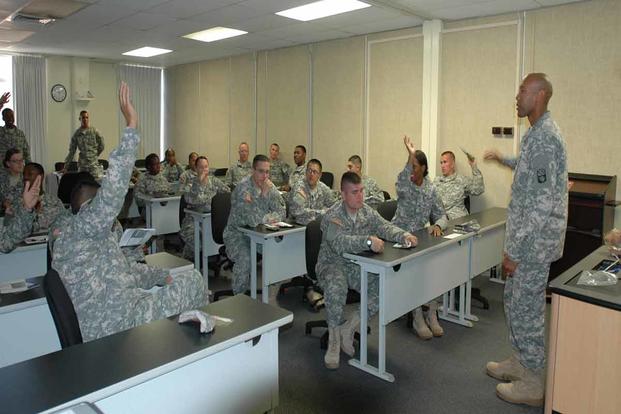Army educators are collaborating with scores of colleges and universities to chart the parameters for the new Army University, or ArmyU.
"We have the vision, direction and charter," for ArmyU, but not all the specifics, said Brig. Gen. John S. Kem, provost for the new institution. He asked faculty and staff from 80 colleges and universities to "help figure out" those specifics during a symposium on Fort Leavenworth, Kansas, Dec. 2 - 3.
The university will be an "umbrella" organization with several overarching goals, Kem said. First and foremost is its purpose to improve the quality of Army education.
ArmyU will also focus on providing college credit and credentialing to Soldiers for their military education and experience. It's one of the big things the university is working on early, explained one of its staff members. It's reaching out to academia to help standardize credentialing.
The university may also be a "clearinghouse" for graduate-level research about the Army, Kem said.
In addition, it may reach out to universities and ask them to help fill Army "educational gaps," he said, indicating that distance learning could play a major role in bridging those gaps.
"As a nascent university, we have some big holes," said Col. Steve Delvaux, vice provost for academic affairs at ArmyU. Until August, the institution had no staff. Some departments are still only one person deep.
Delvaux suggested that some civilian professors might want to participate in a university exchange program or take a sabbatical to help ArmyU stand up its registrar or establish initiatives.
Standing up graduate-level programs for specific career fields like cyber would take the Army years to do on its own, Kem said. He suggested that the Army might take advantage of programs already out there in academia.
DISTANCE LEARNING
One school that is already helping the Army fill some academic gaps is East Carolina University, or ECU, which provides 11 online classes to Army civilians involved in various aspects of education from instructional design and technology, to adult education.
"I think technology is really coming a long way, especially in our online sites," said ECU's Dr. Steven Schmidt, one of the presenters at the symposium.
"In the past we may have had a chat session where people log on and talk to each other via texting," Schmidt said. "Now we can do it with things like Google Hangout and we have programs that allow us to see each other face-to-face on the computer and talk to each other."
Those who take the ECU classes not only learn from the curriculum, Schmidt said, they also learn from example about how to teach online.
"They may be very familiar with teaching in a traditional classroom," Schmidt said about the Army civilians, "but teaching online or teaching in blended learning situations may be fairly new to them."
OTHER INITIATIVES
"There are several other initiatives out there," Delvaux said. He cited The Great Plains initiative as an example of good collaboration. The Great Plains initiative is a consortium of colleges that have relatively the same fees and accept each other's courses toward degrees.
"So a person could take a course from the University of Nebraska, one from Kansas State and one from the other schools and colleges that participate...and in the end get the degree."
"We're kind of thinking along the same lines with Army University on how we establish our degree programs," Delvaux said. Soldiers who take courses at various Army schools - and even some at collaborating state or private universities - might someday be able to put them all together for a degree, he explained.
"A lot of it is focused on our NCO [noncommissioned officer] and enlisted corps, because that's where we think the biggest bang for the buck is," he said.
Delvaux said approximately 80 percent of the Army is enlisted, and the enlisted force is also the most underserved when it comes to higher education.
"Only 13 percent of the population eligible for tuition assistance is actually taking advantage of the benefit," Delvaux said.
"There's a lot of money out there. We have these programs; we have the GI Bill; we have tuition assistance where they can reach out and take advantage of those courses you are offering either on base, at your local colleges or through distance learning, that we would like to leverage," he told the professors at the symposium.
"So we'd like to set up these degree programs, again where you recognize Army schools and their experience, and then they take your courses to fill in the gaps of what they're missing. At the end of the day, they get that broad-based liberal-arts education.
"We think that makes a better force," Delvaux said.
CREDIT FOR LEADERSHIP
The Army's schools are collaborating more, he said. Voluntary education is being "married up" with professional military schools. Next, ArmyU would like to work in partnerships with state and private schools, he said.
"A lot of the engineer, the logistics, the technical skills, those easily translate and you understand those," Delvaux said. "But you don't necessarily understand what an infantryman does, or what an armor [troop] or tanker does, or field artilleryman does, and it doesn't translate as easily into civilian skills."
By the time infantrymen have 10 to 12 years of service, they've been to the Basic Leader Course, the Advanced Leader Course and the Senior Leader Course. They've probably also spent five or six years in leadership positions such team leader, squad leader and platoon sergeant, Delvaux said.
"Are you recognizing that leadership experience - that management, those skills that they have? Giving them credit for prior learning? So that's what we're looking at when we're developing these degree programs with you all," he said.
"Part of our Army University challenge is how do you increase the partnerships, expand the opportunities, work credentialing differently, re-credit programs differently, and ultimately improve our military education," Kem said. "There is no one single solution."

© Copyright 2025 Army.mil/News. All rights reserved. This material may not be published, broadcast, rewritten or redistributed.




